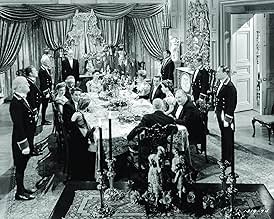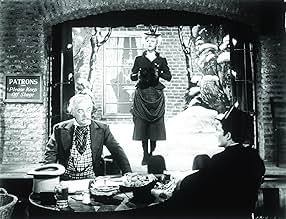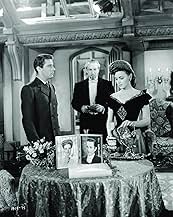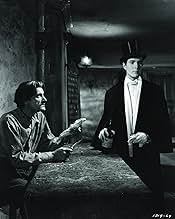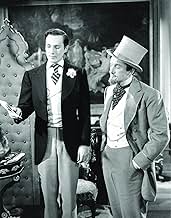NOTE IMDb
7,5/10
15 k
MA NOTE
Un jeune homme corrompu parvient curieusement à garder sa beauté juvénile, mais un tableau spécial révèle progressivement sa laideur intérieure.Un jeune homme corrompu parvient curieusement à garder sa beauté juvénile, mais un tableau spécial révèle progressivement sa laideur intérieure.Un jeune homme corrompu parvient curieusement à garder sa beauté juvénile, mais un tableau spécial révèle progressivement sa laideur intérieure.
- Réalisation
- Scénario
- Casting principal
- Récompensé par 1 Oscar
- 3 victoires et 4 nominations au total
Renee Carson
- Young French Woman
- (as Renie Carson)
Lilian Bond
- Kate
- (as Lillian Bond)
Devi Dja
- Lead Dancer
- (as Devi Dja and Her Balinese Dancers)
Avis à la une
It is a mystery. Or is it mind over matter? The power of a mysterious painting depicted in this timeless tale of Oscar Wilde's imagination -- probing the depth of life's meaning.
It's costume drama, story began in London 1886. Definitely has an element of intrigue -- "a painting with a life of its own". It's eerie. It's dramatic. Its theme is scary. Such is a "deadly" wish of the main character, Dorian Gray: "If only the picture (a portrait of Dorian Gray) can change, and I can always be as I am now. I'd give my soul for that." Dorian Gray's obsession with youth became eternal youth.
Imagine that as time goes by, he will always stay the same rich attractive young man that he is -- never grow old, while the picture will take on the changes -- his soul and character. Conscience, no longer he has -- the picture took it on. The story describes how Dorian Gray spends his life henceforth and the consequences that entail.
A very young Angela Lansbury, after her debut in George Cuckor's 1944 "Gaslight", portrays the innocent young actress Sibyl Vane from the poor side of town. The bet between the characters of George Sanders and Hurd Hatfield brought to mind the cruel intentions of Neil LaBute's 1997 "In the Company of Men". George Sanders is the cynical callous Lord Henry Wotton. The events all happen in a seemingly civil manner, immersed in the society of the rich. Have and have-nots are juxtaposed.
The film is essentially in Black and White, with only the specific content of the picture of Dorian Gray in color when we see it through Dorian's eyes.
It's another B/W classics gem, well-cut and impeccably presented. It encompasses sentiments and all elements: mystery, intrigue, love lost, friendships, regrets, and fear. Dorian Gray with a tormented inside -- pining for the return of his soul. Is this the Devil's advocate? You see no hell depicted as in Vincent Ward's 1998 "What Dreams May Come", or Woody Allen's 1997 "Deconstructing Harry" or Taylor Hackford's 1998 "The Devil's Advocate". No glamorous, elaborate take on the Devil, but the atmosphere provided that suggestion. There's no special effects, yet you can feel the twistedness: a man asking for help within yet unable to help himself because he's a lost soul. The temperature of the movie seems like being in 10 degree Celsius -- cold in sentiment and tone. There was a glimmer of warmth -- it flickered and faded with the innocent Sibyl Vane character.
The subject matter is timeless even though the film was made in 1945. The story is fascinating in spite of the pace which may not be at breakneck speed as in today's action packed, sound effects filled movies.
You can say it's pseudo sci-fi -- a foreboding tale it is. By and by, Dorian Gray's unchanging mask-like face reminds me of "Mr. Sardonicus" (William Castle's 1961). His behaviors are no longer placid -- gradually turning into hideous evils. This film questions one's probity. The mystery of life is to live it not to attain immortality. How uninteresting it'd be to be changeless and ageless? (John Boorman's 1974 sci-fi "Zardoz" with Sean Connery and Charlotte Rampling came to mind). Growth and change are intrinsic elements of life. Life and death go hand in hand cyclically. A truly worthwhile effort from writer/director Albert Lewin.
It's costume drama, story began in London 1886. Definitely has an element of intrigue -- "a painting with a life of its own". It's eerie. It's dramatic. Its theme is scary. Such is a "deadly" wish of the main character, Dorian Gray: "If only the picture (a portrait of Dorian Gray) can change, and I can always be as I am now. I'd give my soul for that." Dorian Gray's obsession with youth became eternal youth.
Imagine that as time goes by, he will always stay the same rich attractive young man that he is -- never grow old, while the picture will take on the changes -- his soul and character. Conscience, no longer he has -- the picture took it on. The story describes how Dorian Gray spends his life henceforth and the consequences that entail.
A very young Angela Lansbury, after her debut in George Cuckor's 1944 "Gaslight", portrays the innocent young actress Sibyl Vane from the poor side of town. The bet between the characters of George Sanders and Hurd Hatfield brought to mind the cruel intentions of Neil LaBute's 1997 "In the Company of Men". George Sanders is the cynical callous Lord Henry Wotton. The events all happen in a seemingly civil manner, immersed in the society of the rich. Have and have-nots are juxtaposed.
The film is essentially in Black and White, with only the specific content of the picture of Dorian Gray in color when we see it through Dorian's eyes.
It's another B/W classics gem, well-cut and impeccably presented. It encompasses sentiments and all elements: mystery, intrigue, love lost, friendships, regrets, and fear. Dorian Gray with a tormented inside -- pining for the return of his soul. Is this the Devil's advocate? You see no hell depicted as in Vincent Ward's 1998 "What Dreams May Come", or Woody Allen's 1997 "Deconstructing Harry" or Taylor Hackford's 1998 "The Devil's Advocate". No glamorous, elaborate take on the Devil, but the atmosphere provided that suggestion. There's no special effects, yet you can feel the twistedness: a man asking for help within yet unable to help himself because he's a lost soul. The temperature of the movie seems like being in 10 degree Celsius -- cold in sentiment and tone. There was a glimmer of warmth -- it flickered and faded with the innocent Sibyl Vane character.
The subject matter is timeless even though the film was made in 1945. The story is fascinating in spite of the pace which may not be at breakneck speed as in today's action packed, sound effects filled movies.
You can say it's pseudo sci-fi -- a foreboding tale it is. By and by, Dorian Gray's unchanging mask-like face reminds me of "Mr. Sardonicus" (William Castle's 1961). His behaviors are no longer placid -- gradually turning into hideous evils. This film questions one's probity. The mystery of life is to live it not to attain immortality. How uninteresting it'd be to be changeless and ageless? (John Boorman's 1974 sci-fi "Zardoz" with Sean Connery and Charlotte Rampling came to mind). Growth and change are intrinsic elements of life. Life and death go hand in hand cyclically. A truly worthwhile effort from writer/director Albert Lewin.
Hurd Hatfield sells his soul so that his portrait ages and reflects his evil while he stays young in "The Picture of Dorian Gray," based on the classic novel by Oscar Wilde. The film also stars George Sanders, Angela Lansbury, Donna Reed, and Peter Lawford. After wishing to stay young forever and falling prey to the words of a cynical friend, Gray goes against what might have been a decent nature and embarks on a vicious life that brings cruelty, sadness, and even death to those with whom he interacts.
The film is striking for several reasons: There is very little of what one would call action; many scenes are quite short; the film relies heavily on narration; the leading man's face remains impassive throughout. This could have been a recipe for disaster, but instead, "The Picture of Dorian Gray" is an extremely compelling film. This sumptuous production is meticulously photographed, with wonderful use of shadows which help create a dark atmosphere. The performances are excellent, particularly those of a very young Angela Lansbury and George Sanders. Peter Lawford and Donna Reed are the beautiful young things who don't have to depend on a portrait for youth.
Hurd Hatfield surely had one of the strangest faces in film - he certainly looked the part of a young, almost pretty Englishman, with his unlined face, high cheekbones, and full lips. As the role dictates, he was appropriately detached and lacking emotion. Six or seven years earlier, this role would have been perfect for Tyrone Power, who would have imbued it with more charm - making the evil inside Dorian all the more difficult to accept among his friends, and thus, his true personality would have seemed more treacherous. Given the way Hatfield played it, I had no problem believing he was capable of anything, and wondered why his friends didn't buy the nasty rumors.
As for the portrait - what a concept. Would that we all had one in our closets. It would put plastic surgeons out of business.
The film is striking for several reasons: There is very little of what one would call action; many scenes are quite short; the film relies heavily on narration; the leading man's face remains impassive throughout. This could have been a recipe for disaster, but instead, "The Picture of Dorian Gray" is an extremely compelling film. This sumptuous production is meticulously photographed, with wonderful use of shadows which help create a dark atmosphere. The performances are excellent, particularly those of a very young Angela Lansbury and George Sanders. Peter Lawford and Donna Reed are the beautiful young things who don't have to depend on a portrait for youth.
Hurd Hatfield surely had one of the strangest faces in film - he certainly looked the part of a young, almost pretty Englishman, with his unlined face, high cheekbones, and full lips. As the role dictates, he was appropriately detached and lacking emotion. Six or seven years earlier, this role would have been perfect for Tyrone Power, who would have imbued it with more charm - making the evil inside Dorian all the more difficult to accept among his friends, and thus, his true personality would have seemed more treacherous. Given the way Hatfield played it, I had no problem believing he was capable of anything, and wondered why his friends didn't buy the nasty rumors.
As for the portrait - what a concept. Would that we all had one in our closets. It would put plastic surgeons out of business.
Based on a story by Oscar Wilde, The Picture of Dorian Gray tells the story of a man that sells his soul for eternal youth. After having his portrait done, Dorian Gray, under the influence of the eloquent Lord Henry Wotton, wishes for the picture to age instead of him so that he may be blessed with eternal youth. After the death of his wife-to-be, Dorian embarks on a life of pleasure and sins, which don't affect the man in the slightest, but leaves it mark on the portrait which descends into a horrid impression of the handsome young man it's portraying...
This film is fantastically well put together. The acting, directing and writing are all stellar, which make this film one pleasant viewing indeed. The real plaudits for this movie, however, go to the writer of the original novel; Oscar Wilde. The story itself is ingenious. Of course, the idea of selling one's soul had been done before (the German legend, Faust, springs to mind instantly), but never in this way. The portrait itself is a genius idea and it allows us to see the man and the sin as different things. However, through it's ending; it also allows the audience to see that the two are linked, and overall giving a good commentary on body, soul and sin. The story has obvious themes of vanity and the lust for eternal youth entwined within it, both of which are sins in themselves. The main character of Dorian Gray is a man that is a victim of influence, and we can feel for him in that way; but he's also an ugly sinner on the inside, making the audience hate him. This is a strange situation for an audience to be in, and in the end; all that's left for him is indifference.
The film moves slowly, but this is definitely to it's advantage as it allows us to get to know the characters, and if it wasn't for that the horror wouldn't be able to work as it needs our emotional impact to function. The horror in the story is rather subdued, but this is one of the most horrific tales ever told. I think most people will agree that this kind of horror - the brooding, personal kind - is much more horrifying than anything that men with knives and any amount of jumpy moments can muster.
This film is fantastically well put together. The acting, directing and writing are all stellar, which make this film one pleasant viewing indeed. The real plaudits for this movie, however, go to the writer of the original novel; Oscar Wilde. The story itself is ingenious. Of course, the idea of selling one's soul had been done before (the German legend, Faust, springs to mind instantly), but never in this way. The portrait itself is a genius idea and it allows us to see the man and the sin as different things. However, through it's ending; it also allows the audience to see that the two are linked, and overall giving a good commentary on body, soul and sin. The story has obvious themes of vanity and the lust for eternal youth entwined within it, both of which are sins in themselves. The main character of Dorian Gray is a man that is a victim of influence, and we can feel for him in that way; but he's also an ugly sinner on the inside, making the audience hate him. This is a strange situation for an audience to be in, and in the end; all that's left for him is indifference.
The film moves slowly, but this is definitely to it's advantage as it allows us to get to know the characters, and if it wasn't for that the horror wouldn't be able to work as it needs our emotional impact to function. The horror in the story is rather subdued, but this is one of the most horrific tales ever told. I think most people will agree that this kind of horror - the brooding, personal kind - is much more horrifying than anything that men with knives and any amount of jumpy moments can muster.
It's hard to say what it is about "The Picture of Dorian Gray" that I enjoyed so much, but I did like it. Hurd Hatfield at first seems miscast and ineffective as the titular character, but somewhere around the one hour mark, his one and only expression begins to grow on you until you feel just as unnerved by his presence as those who come in contact with him in the story. George Sanders--from what I've seen--played one character his enter career but played it so well, and his performance in this film is no exception. Angela Lansbury is surprisingly sympathetic as the sad and timid singer. The only one in the cast who really doesn't work is Donna Reed. Her character feels tacked on, and she isn't allowed to do much but look faithful and beautiful.
The film is shot wonderfully, and Harry Stradling's cinematography gives the East End scenes a dark, atmospheric counter balance to the rather plain and flat interiors of Dorian's home. The swinging lamp was a nice touch and reminded me of "Psycho"'s finale.
I suppose my only criticism is toward the end, the story introduced one or two characters without giving them proper context or background (I'm thinking of the Allen Campbell character). I'm assuming Dorian "convinces" him to take part in his plans because of some sort past homosexual tryst, but it seemed unfair to bring him in they way he was, have him serve the role he does, and then disappear so quickly without explanation. And speaking of suggested themes: Is it just me, or could you make an argument that Dorian is Jack the Ripper? Maybe it's actually pretty obvious or maybe I'm just interpreting too much into the story, but that's what I got out of it.
P.S. I had the opportunity to see the actual painting from the film during an Ivan Albright exhibit at the Metropolitan Museum of Art in 1997. It's even more gruesome in person.
The film is shot wonderfully, and Harry Stradling's cinematography gives the East End scenes a dark, atmospheric counter balance to the rather plain and flat interiors of Dorian's home. The swinging lamp was a nice touch and reminded me of "Psycho"'s finale.
I suppose my only criticism is toward the end, the story introduced one or two characters without giving them proper context or background (I'm thinking of the Allen Campbell character). I'm assuming Dorian "convinces" him to take part in his plans because of some sort past homosexual tryst, but it seemed unfair to bring him in they way he was, have him serve the role he does, and then disappear so quickly without explanation. And speaking of suggested themes: Is it just me, or could you make an argument that Dorian is Jack the Ripper? Maybe it's actually pretty obvious or maybe I'm just interpreting too much into the story, but that's what I got out of it.
P.S. I had the opportunity to see the actual painting from the film during an Ivan Albright exhibit at the Metropolitan Museum of Art in 1997. It's even more gruesome in person.
Like 'The Importance of Being Earnest', Oscar Wilde's only novel 'The Picture of Dorian Grey' is one of his most famous works for very good reason. It is philosophical essentially in nature, but also very chilling, dripping in atmosphere and full of Wilde's sparkling wit.
This 1945 film adaptation had so much going for it, with the involvement of great actors like George Sanders and Angela Lansbury for one thing. 72 years on, it's still one of the best overall versions of 'The Picture of Dorian Grey' there is/. Surprisingly, for film adaptations of classic literature made in the "classic era" it's pretty faithful, but 'The Picture of Dorian Grey' (1945) is actually even more successful on its own terms.
It may not be flawless, but it comes close. Donna Reed's character feels very tacked on and Reed, despite looking radiant, looks, sounds and acts out of place. Peter Lawford, in an admittedly limited role, spends his entire screen time looking bewildered and like he had little idea what to do with what he had.
Don't on the other hand let the pacing put you off. It is deliberate and measured, but to me it was never dull or too slow. The atmosphere, the performances and Wilde's dialogue were instrumental in making the film compelling and they shine brilliantly.
Visually, 'The Picture of Dorian Grey' (1945) is notably striking. As elegant as the costumes are, how classy and moodily atmospheric the lighting is and how sumptuous the Gothic set design is, it's the outstanding cinematography (that enhances everything so much) that's the star. The music score is resolutely haunting, also with inspired use of Beethoven, Mozart and Chopin, and the direction has immense sophisticated style.
Wilde's writing shines firmly to the fore as one would expect, some great lines that have full impact. Even with more measured pacing, the storytelling is rich in chilling atmosphere and class with the impact of the portrait having a truly startling effect.
All the acting is very strong and one of 'The Picture of Dorian Grey's' best elements. Sanders has the best lines (classic Wilde witticisms and cynical but witty observations) and the most interesting character (like a human Mephistopheles Oscar Wilde-style), and Sanders' performance is very like his Oscar-winning performance in 'All About Eve' five years later, a once in a lifetime role that he was born to play and it is difficult to imagine anybody else deliver those lines the way Sanders did so effortlessly. Lansbury is both chirpy and touching, plus she has rarely looked so young or more beautiful, her rendition of "Good Bye Little Yellow Bird" wrenches the heart also.
Hurd Hartfield's muted performance may be unimpressive or controversial, and it is easy to overlook him in favour of the juicier supporting roles. To me though, the mute inexpressive quality of his acting added quite vastly to the deceptively chilling nature of the role itself. Lowell Gilmore also stands out.
Overall, a near classic and one of the better film adaptations of Wilde's work, if one is looking for elegance, atmosphere and great production values, writing and performances look no further. 9/10 Bethany Cox
This 1945 film adaptation had so much going for it, with the involvement of great actors like George Sanders and Angela Lansbury for one thing. 72 years on, it's still one of the best overall versions of 'The Picture of Dorian Grey' there is/. Surprisingly, for film adaptations of classic literature made in the "classic era" it's pretty faithful, but 'The Picture of Dorian Grey' (1945) is actually even more successful on its own terms.
It may not be flawless, but it comes close. Donna Reed's character feels very tacked on and Reed, despite looking radiant, looks, sounds and acts out of place. Peter Lawford, in an admittedly limited role, spends his entire screen time looking bewildered and like he had little idea what to do with what he had.
Don't on the other hand let the pacing put you off. It is deliberate and measured, but to me it was never dull or too slow. The atmosphere, the performances and Wilde's dialogue were instrumental in making the film compelling and they shine brilliantly.
Visually, 'The Picture of Dorian Grey' (1945) is notably striking. As elegant as the costumes are, how classy and moodily atmospheric the lighting is and how sumptuous the Gothic set design is, it's the outstanding cinematography (that enhances everything so much) that's the star. The music score is resolutely haunting, also with inspired use of Beethoven, Mozart and Chopin, and the direction has immense sophisticated style.
Wilde's writing shines firmly to the fore as one would expect, some great lines that have full impact. Even with more measured pacing, the storytelling is rich in chilling atmosphere and class with the impact of the portrait having a truly startling effect.
All the acting is very strong and one of 'The Picture of Dorian Grey's' best elements. Sanders has the best lines (classic Wilde witticisms and cynical but witty observations) and the most interesting character (like a human Mephistopheles Oscar Wilde-style), and Sanders' performance is very like his Oscar-winning performance in 'All About Eve' five years later, a once in a lifetime role that he was born to play and it is difficult to imagine anybody else deliver those lines the way Sanders did so effortlessly. Lansbury is both chirpy and touching, plus she has rarely looked so young or more beautiful, her rendition of "Good Bye Little Yellow Bird" wrenches the heart also.
Hurd Hartfield's muted performance may be unimpressive or controversial, and it is easy to overlook him in favour of the juicier supporting roles. To me though, the mute inexpressive quality of his acting added quite vastly to the deceptively chilling nature of the role itself. Lowell Gilmore also stands out.
Overall, a near classic and one of the better film adaptations of Wilde's work, if one is looking for elegance, atmosphere and great production values, writing and performances look no further. 9/10 Bethany Cox
Le saviez-vous
- AnecdotesIn the novel, Sibyl Vane called Dorian Gray "Prince Charming", not "Sir Tristan".
- GaffesAt approximately 34:35 into the film, the time on the clock in the room suddenly changes from just after 2 o'clock to 3 o'clock. Then at approximately 37:00 it moves back to 2:05 and then to 2:09 as Dorian continues to play the piano.
- Citations
Lord Henry Wotton: "If I could get back my youth, I'd do anything in the world except get up early, take exercise or be respectable."
- Versions alternativesSome prints are slightly edited, omitting Dorian's prayer and Lord Henry's line, "Heaven forgive me" in the final scene.
- ConnexionsFeatured in The Cinematographer (1951)
- Bandes originalesGood-Bye, Little Yellow Bird
(uncredited)
Lyrics and Music by C.W. Murphy and William Hargreaves
Performed by Angela Lansbury
Meilleurs choix
Connectez-vous pour évaluer et suivre la liste de favoris afin de recevoir des recommandations personnalisées
- How long is The Picture of Dorian Gray?Alimenté par Alexa
- Who narrated the film?
- What is 'The Picture of Dorian Gray' about?
- Is "The Picture of Dorian Gray" based on a book?
Détails
- Date de sortie
- Pays d’origine
- Site officiel
- Langue
- Aussi connu sous le nom de
- El retrato de Dorian Gray
- Lieux de tournage
- Société de production
- Voir plus de crédits d'entreprise sur IMDbPro
Box-office
- Budget
- 3 500 000 $US (estimé)
- Durée1 heure 50 minutes
- Couleur
- Rapport de forme
- 1.37 : 1
Contribuer à cette page
Suggérer une modification ou ajouter du contenu manquant

Lacune principale
By what name was Le Portrait de Dorian Gray (1945) officially released in India in English?
Répondre

